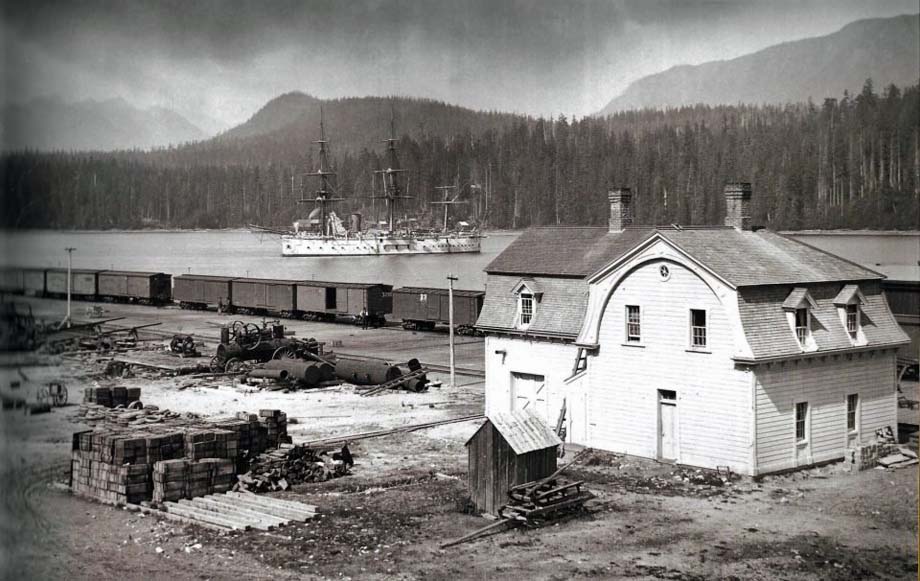
Port Moody British Columbia - The arrangement was simple, Canada would get British Columbia and
Port Moody would get the railroad.
In the early 1880s, a transcontinental line was stretching toward the West Coast as unsteadily as a deep sleeper
reaching for the alarm clock.
In Port Moody the only thing higher than the hopes were the real estate prices.
By 1885, land at Clarke Street that had been worth $15 sold for $1,000.
But, as it turned out, the plan was already going off the rails.
Prime Minister John A. Macdonald had promised that, within 10 years of BC joining Canada, a rail line would connect
Victoria.
But 11 years later, the Canadian Pacific Railway was moving like St. Johns Street traffic at rush hour.
With the line "impeded by political, management, and financing problems," Macdonald recruited William
Cornelius Van Horne.
 I doubt Macdonald had anything to do with it as CP Limited's
directors at the time were mainly involved.
I doubt Macdonald had anything to do with it as CP Limited's
directors at the time were mainly involved.
Originally from Illinois, Van Horne had ben tasked with keeping the trains on time during the U.S. Civil
War.
After taking the job in 1882, Van Horne fired his engineering staff and moved the rail line through the Kicking Horse
Pass of the Rocky Mountains.
Van Horne was known for showing up at remote sites without warning where he would "assess progress and shout
orders," according to the Canadian Encyclopedia.
 Hmmm... not so sure about shouting orders but suspect he had a
strong presence. Here's a story involving Van Horne: He was a telegrapher during his time on an Illinois
railroad. One day while riding a CPR train he noticed a couple of employees playing cards, on Company time.
Instead of confronting them directly, when the train reached the next station he alighted and sent a telegram
ahead to the next stop stating the two employees playing cards were to cease that behaviour. When the train
arrived the employees received the telegram, or notice, and were shocked to discover the boss knew what they
were up to.
Hmmm... not so sure about shouting orders but suspect he had a
strong presence. Here's a story involving Van Horne: He was a telegrapher during his time on an Illinois
railroad. One day while riding a CPR train he noticed a couple of employees playing cards, on Company time.
Instead of confronting them directly, when the train reached the next station he alighted and sent a telegram
ahead to the next stop stating the two employees playing cards were to cease that behaviour. When the train
arrived the employees received the telegram, or notice, and were shocked to discover the boss knew what they
were up to.
A total of 259 kilometres of rail had been built during he previous construction season.
In Van Horne's first year, 671 kilometres stretched into the prairies.
On 7 Nov 1885 a worker drove the last spike into the railway.
 That worker was Donald A. Smith the most senior Company officer
present at the driving of the Last Spike. Later dubbed Lord Strathcona.
That worker was Donald A. Smith the most senior Company officer
present at the driving of the Last Spike. Later dubbed Lord Strathcona.
Nine months later, on 4 Jul 1886, a passenger train from Montreal arrived in Port Moody.
The Victoria Daily Times called it, "the most wonderful feat in railroading on record."
There were celebrations amid streets draped with banners, according to one account.
For 10 months, Port Moody was the centre of the province.
A plaque commemorated the last spike reads, "thus completing the bond of union and making Canada independent in
the matter of railway transportation."
In the summer of 1886 Port Moody was the end of the line.
However, that wasn't the end of the story.
Van Horne judged Port Moody to be a little skinny between water and hillside.
Having overseen 4,600 kilometres of rail, extending the line into Vancouver seemed simple enough.
The decision sparked "amazement and anger," as well as lawsuits that turned out to be
unsuccessful.
On 23 May 1887 a transcontinental passenger train from Montreal arrived in Coal Harbour, thus relegating Port Moody
to, "merely another stop en route to Vancouver," wrote historian Chuck Davis.
In Port Moody's collected history, the writer noted that a cairn in the city commemorates the completion of the
railway.
"There is no cairn for William Van Horne," the writer added, noting Port Moody's population was stuck at
about 250 for the next two decades.
While it's generally acknowledged that the rail extension allowed Vancouver to become BC's main port, and its
commercial centre, there is a semantic counterargument.
W.H. Evans was the engineer who drove the train into Port Moody in 1886.
Fifty years later, he told the Vancouver Sun's James Dyer that, "officially," Port Moody is still the
terminus.
"They merely built a branch line into Vancouver, and it is a only a branch line still," he said.
Jeremy Shepherd.
(likely no image with original article)
(usually because it's been seen before)
(the image is altered or fake)
provisions in Section 29 of the
Canadian Copyright Modernization Act.

